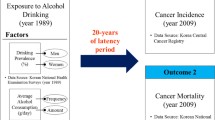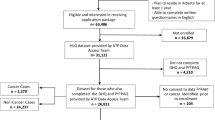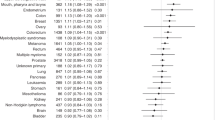Abstract
Purpose
Germany lacks an up-to-date assessment of the cancer burden attributable to alcohol. Therefore, cancer incidence attributable to this exposure was estimated for colorectal, liver, breast, and upper aerodigestive tract (UADT) cancer. Additionally, the impact of alcohol on UADT cancer was analyzed by smoking status, to account for synergistic interactions between these two risk factors.
Methods
Alcohol consumption and smoking prevalence from a nationwide survey in Germany 2008–2011 were combined with relative risks of incident cancer from meta-analyses to obtain population attributable risks (PARs), indicating the proportion of cancers that could be avoided by eliminating a risk factor. Each PAR was multiplied with the respective cancer incidence for 2010 to calculate the absolute number of attributable cases.
Results
In Germany, for the year 2010, approximately 13,000 incident cancer cases could be attributed to alcohol consumption (3 % of total cases). PAR was highest for esophageal cancer (men: 47.6 % and women: 35.8 %) and lowest for colorectal cancer in men (9.7 %) and breast cancer in women (6.6 %). Among women, moderate consumption levels account for the greatest PAR overall, whereas heavy drinking contributes considerably to overall PAR among men. Additionally, moderate-to-heavy drinking among smokers substantially contributes to the overall PAR of UADT cancers compared to drinking among non-smokers.
Conclusion
In Germany, a substantial proportion of cases of common cancers can be attributed to alcohol consumption, even when consumed at moderate levels. Alcohol consumption with concurrent tobacco smoking is especially important for cancers of the UADT. These findings strengthen the rationale for prevention measures that address exposure at all levels.
Similar content being viewed by others
Abbreviations
- AMSTAR:
-
Assessment of multiple systematic reviews
- DEGS1:
-
German Health Interview and Examination Survey for Adults (2008–2011)
- FFQ:
-
Food frequency questionnaire
- IARC:
-
International Agency for Research on Cancer
- PAR:
-
Population attributable risk
- RKI:
-
Robert Koch Institute
- RR:
-
Relative risk
- UADT:
-
Upper aerodigestive tract
References
IARC (2012) A review of human carcinogens. Part E: personal habits and indoor combustions. In: World Health Organization, International Agency for Research on Cancer (eds) IARC monographs on the evaluation of carcinogenic risks to humans. World Health Organization, Lyon
Boffetta P, Hashibe M (2006) Alcohol and cancer. Lancet Oncol 7:149–156
Wight AJ, Ogden GR (1998) Possible mechanisms by which alcohol may influence the development of oral cancer—a review. Oral Oncol 34:441–447
Pelucchi C, Gallus S, Garavello W, Bosetti C, Vecchia CL (2008) Alcohol and tobacco use, and cancer risk for upper aerodigestive tract and liver. Eur J Cancer Prev 17:340–344
Anantharaman D, Marron M, Lagiou P et al (2011) Population attributable risk of tobacco and alcohol for upper aerodigestive tract cancer. Oral Oncol 47:725–731
Hashibe M, Brennan P, Chuang S et al (2009) Interaction between tobacco and alcohol use and the risk of head and neck cancer: pooled analysis in the international head and neck cancer epidemiology consortium. Cancer Epidemiol Biomark Prev 18:541–550
Schütze M, Boeing H, Pischon T et al (2011) Alcohol attributable burden of incidence of cancer in eight European countries based on results from prospective cohort study. BMJ 342:d1584
John U, Hanke M (2002) Tobacco smoking- and alcohol drinking-attributable cancer mortality in Germany. Eur J Cancer Prevention. 11:11–17
Lampert T, von der Lippe E, Müters S (2013) Prevalence of smoking in the adult population of Germany. Results of the German Health Interview and Examination Survey for Adults (DEGS1). Bundesgesundheitsbl Gesundheitsforsch Gesundheitsschutz 56:802–808
Gaertner B, Meyer C, John U, Freyer-Adam J (2013) Alkohol - Zahlen und Fakten zum Konsum. In: Deutsche Hauptstelle für Suchtfragen e.V. (ed) Jahrbuch Sucht 2013. Pabst, Hamm
Hamajima N, Cancer CGoHFiB (2002) Alcohol, tobacco and breast cancer—collaborative reanalysis of individual data from 53 epidemiological studies, including 58,515 women with breast cancer and 95,067 women without the disease. Br J Cancer 87:1234–1245
Scheidt-Nave C, Kamtsiuris P, Gößwald A et al (2012) German Health Interview and Examination Survey for Adults (DEGS)—design, objectives and implementation of the first data collection wave. BMC Public Health 12:730
Haftenberger M, Heuer T, Heidemann C, Kube F, Krems C, Mensink GB (2010) Relative validation of a food frequency questionnaire for national health and nutrition monitoring. Nutr J 9:36
Castellsagué X, Munoz N, De Stefani E et al (1999) Independent and joint effects of tobacco smoking and alcohol drinking on the risk of esophageal cancer in men and women. Int J Cancer 82:657–664
Fedirko V, Tramacere I, Bagnardi V et al (2011) Alcohol drinking and colorectal cancer risk: an overall and dose–response meta-analysis of published studies. Ann Oncol 22:1958–1972
Ridolfo B, Stevenson C (2001) The quantification of drug-caused mortality and morbidity in Australia, 1998. In: Australian Institute of Health and Welfare (ed) Drug statistics series. Australian Institute of Health and Welfare, Canberra
Turati F, Galeone C, Rota M et al (2014) Alcohol and liver cancer: a systematic review and meta-analysis of prospective studies. Ann Oncol 25:1526–1535
Shea BJ, Grimshaw JM, Wells GA et al (2007) Development of AMSTAR: a measurement tool to assess the methodological quality of systematic reviews. BMC Med Res Methodol 7
Kraywinkel K, Barnes B, Dahm S, Haberland J, Nennecke A, Stabenow R (2014) Nationwide statements from regional data. Methods of the Center for Cancer Registry Data. Bundesgesundheitsbl Gesundheitsforsch Gesundheitsschutz 57:13–21
Tseng M, Weinberg CR, Umbach DM, Longnecker MP (1999) Calculation of population attributable risk for alcohol and breast cancer (United States). Cancer Causes Control 10:119–123
Bruzzi P, Green SB, Byar DP, Brinton LA, Schairer C (1985) Estimating the population attributable risk for multiple risk factors using case–control data. Am J Epidemiol 122:904–914
Canty AJ, Davison AC (1999) Resampling-based variance estimation for labour force surveys. J R Stat Soc Ser D (Stat) 48:379–391
Lumley T (2009) Analysis of complex survey samples. R-package “survey”, 3.30-3 edn. R Foundation, Vienna
RKI (2013) Cancer in Germany 2009/2010. Robert Koch Institute and the Association of Population-based Cancer Registries in Germany, Berlin
Trichopoulos D, Bamia C, Lagiou P et al (2011) Hepatocellular carcinoma risk factors and disease burden in a European cohort: a nested case–control study. J Natl Cancer Inst 103:1686–1695
Parkin DM (2011) Cancers attributable to consumption of alcohol in the UK in 2010. Br J Cancer 105:S14–S18
Eliasen M, Becker U, Gronbaek M, Juel K, Schurmann TolstrupJ (2014) Alcohol-attributable and alcohol-preventable mortality in Denmark: an analysis of which intake levels contribute most to alcohol’s harmful and beneficial effects. Eur J Epidemiol 29:15–26
Ferraroni M, Decarli A, Franceschi S et al (1996) Validity and reproducibility of alcohol consumption in Italy. Int J Epidemiol 25:775–782
Giovannucci E, Colditz GA, Stampfer MJ et al (1991) The assessment of alcohol consumption by a simple self-administered questionnaire. Am J Epidemiol 133:810–817
Lubin JH, Purdue M, Kelsey K et al (2009) Total exposure and exposure rate effects for alcohol and smoking and risk of head and neck cancer: a pooled analysis of case–control studies. Am J Epidemiol 170:937–947
Grewal P, Viswanathen VA (2012) Liver cancer and alcohol. Clin Liver Dis 16:839–850
La Vecchia C, Negri E, Cavalieri d’Oro L, Franceschi S (1998) Liver cirrhosis and the risk of primary liver cancer. Eur J Cancer Prev 7:315–320
Bagnardi V, Blangiardo M, La Vecchia C, Corrao G (2001) Alcohol consumption and the risk of cancer. Alcohol Res Health 25:263–270
Weikert C, Dietrich T, Boeing H et al (2009) Lifetime and baseline alcohol intake and risk of cancer of the upper aero-digestive tract in the European Prospective Investigation into Cancer and Nutrition (EPIC) study. Intl J Cancer 125:406–412
Singer MV, Teyssen S (2001) Alkoholassoziierte Organschäden. Befunde in der Inneren Medizin, Neurologie und Geburtshilfe/Neonatologie. Dtsch Ärztebl 98:A2109–A2120
Acknowledgments
The authors thank all the German cancer registries as well as the teams of the German health survey at the Robert Koch Institute for providing the comprehensive data sets.
Conflict of interest
The authors declare that they have no conflicts of interest.
Author information
Authors and Affiliations
Corresponding author
Electronic supplementary material
Below is the link to the electronic supplementary material.
Rights and permissions
About this article
Cite this article
Wienecke, A., Barnes, B., Neuhauser, H. et al. Incident cancers attributable to alcohol consumption in Germany, 2010. Cancer Causes Control 26, 903–911 (2015). https://doi.org/10.1007/s10552-015-0566-8
Received:
Accepted:
Published:
Issue Date:
DOI: https://doi.org/10.1007/s10552-015-0566-8




